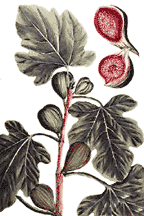Bay Gardener’s Guide
to Growing Fresh Figs
So good and easy they must be from the Gar den of Eden
den of Eden
Imagine picking a ripe fig and eating it fresh from the plant. You can do better than imagining this treat. Figs are a simple fruit to grow and never need to be sprayed because they have no enemies: Neither insects nor disease affect them.
The brown Turkish fig is the most dependable variety to grow in Southern Maryland and has a delicious flavor. These deciduous plants do not need the cross pollination of two or more varieties in the immediate area to produce fruit.
Fig plants need plenty of room to grow. A single plant produces multiple stems and can spread rapidly, becoming a large shrub. Allow at least 50 to 100 square feet of space for each plant. Full sun helps fig plants to become productive. Grown in the shade, they produce lots of foliage but little fruit.
Do not fertilize figs if the stems are growing six feet or more per year. Fertilizing these plants can create fig monsters.
Avoid severe winter damage by planting figs on a southern slope or against the south wall of a building to benefit from reflective heat during the winter months.
In severe winters, cold temperatures may kill fig plants to the ground. If this occurs, cut the dead stems down to the ground; new stems will appear and produce a fall crop. If the tops of the plants are not damaged from winter cold, you will harvest a summer crop as well as a fall crop.
The best times to prune are spring and summer. Prune your fig by cutting away dead wood, thinning stems to allow more sunlight into the center of the plant or removing stems that have grown too large.
Finally, you’ll know when your fruit is ripe and ready for picking when it droops and feels soft to the touch. Figs picked in rigid upright condition will not ripen after picking and will never develop the delicious flavor of a fig that is harvested at its peak of ripeness.
What to Do about Bamboo
Q A neighbor years ago planted bamboo, and it has taken over. I have been digging to get rid of it, through six layers of roots. I sprayed one small plant with Roundup three times: still living. I don’t like to use chemicals this close to the Bay, and we have pets. Azaleas and black raspberries are also in the area, which is why I am digging.
–Charles and Janet Weimer, Churchton
A You will never get rid of bamboo by digging. Rhizomes are known to penetrate soils to a depth of three feet. Allow the bamboo to grow all summer. In mid-November, spray the foliage with Roundup at the recommended concentration. In 10 days, repeat the treatment. Spray the bamboo on a bright sunny day, and do not touch the plants until spring to allow the glyphosate to penetrate to all roots. It will kill the bamboo, including all roots, by spring. Roundup is one of the safest herbicides I have ever worked with.
Ask Dr. Gouin your questions at [email protected]. All questions will appear in Bay Weekly. Please include your name and address.